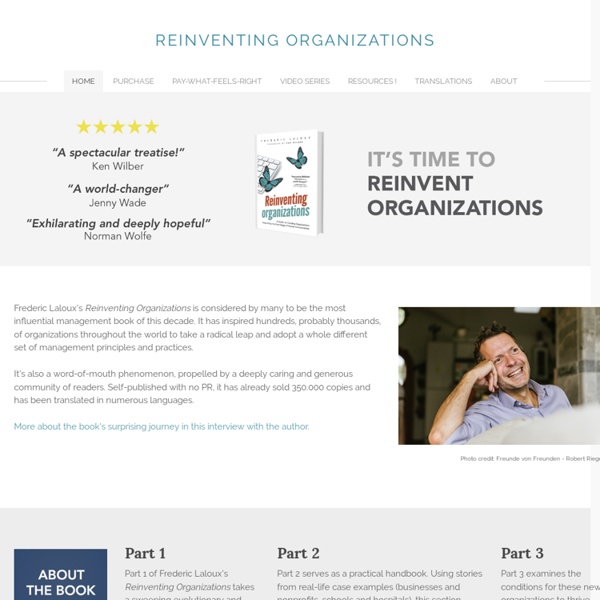



How to Win Friends and Influence People: Dale Carnegie: 9780671027032: Books - Amazon.ca Power and Systems - Organization Workshop This is a workshop that changes people. And organizations. See the impact new perspectives had on these graduates. If you are having problems viewing this video, you can download the full video by clicking here. Using unique, immersive exercises and strategic frameworks grounded in our proven methodology, the Organization Workshop shapes leaders with lasting impact. How it works The Organization Workshop gets to the heart of partnership in organization life – why partnership is critical to organizational success, what gets in the way of it developing, and the role of leaders in making it happen. In combination with these engaging, high-energy activities, there are practical strategic frameworks based on the work of Barry Oshry. This total immersion experience gets participants thinking in their heads and feeling it in the guts, producing a lasting impact that carries over to all the critical change and growth initiatives they are involved in. At the Organization Workshop participants:
untitled The Gallup Path by Gagandeep Anand on Prezi 14 books Educators should read... Here are 14 books that I have read over the last two years that have had a positive effect and impact on me as an educator. Some of these books were read in the book club at Seckman High School, and some were read as part of my doctoral studies. Despite doing a lot more online reading of late (blogs, articles, etc...), I still feel that books play an important role in educator growth and development. The Art of Possibility - Rosamund and Benjamin Zander - The Zanders really do a great job of pushing you to think "outside of the box." The Five Dysfunctions of a Team - Patrick Lencioni - This book hits on some of the most common problems we face when it comes to teams and working together. Winning with People - John Maxwell - This is a fantastic book about building and establishing strong relationships. Tribes - Seth Godin - Godin describes a world in which nothing is possible without "tribes." The Tipping Point - Malcolm Gladwell Brain Rules - John Medina How Full is your Bucket?
A Beginners Guide to Organization Development « Organisation Development Planned ActivityEffects Entire OrganizationRequires Support from All LevelsAims to improve Organizational Effectiveness and HealthGoals Flow from Deliberate Interventions Initiated in Response to Need/Problem like Turnover, Absenteeism,Low Job SatisfactionOften conducted by Outside Consultant-Gives IndependenceViews Organization as a System- InterdependenceInvolves Extensive Planning: deal with Resistance, Systematic Diagnosis, Develop Change PlanBased on Behavioral Science Knowledge: large Range AvailableProcess Often Experiential To construct a great Organization which will nurture and grow the Human Spirit so that the Organization will remain relevant and fit for its constituents. To ensure the organization’s strategic ambition can be delivered to ensure during turbulent change, the organization capability is maintained, aligned and improved and to ensure the organization’s health is maintained or further developed through a planned change effort. Behavioural Approach Technical Approach
Fatty Legs: A True Story: Christy Jordan-Fenton, Margaret Pokiak-Fenton, Liz Amini-Holmes: 9781554512461: Books - Amazon.ca Types of Organizational Designs Types of Organizational Designs Organizational designs fall into two categories, traditional and contemporary. Traditional designs include simple structure, functional structure, and divisional structure. Contemporary designs would include team structure, matrix structure, project structure, boundaryless organization, and the learning organization. I. 1. 2. 3. II. 1. 2. 3. 4. 5. 6.
Making Habits, Breaking Habits: Why We Do Things, Why We Don't, and How to Make Any Change Stick: Jeremy Dean: 9780306822629: Amazon.com: Books The Process Audit This purpose of this article is to describe a framework Hammer refers to as the Process and Enterprise Maturity Model (PEMM). The model emphasizes a whole systems' view where managers think in terms of end-to-end processes rather than activities or functions, and develop process oriented people rather than supervising and rewarding people for focusing on narrow functional goals. The model includes five process enablers and four enterprise capabilities. The process enablers include: Design - how the process is to be executed, Performers - the knowledge and skills of the people involved, Owner - the senior executive responsible for the process, Infrastructure - the systems that support the process, and Metrics - the measurements used to track the performance of the process. The four enterprise capabilities are: A table based on the process enablers is presented to facilitate an assessment of the maturity of a company's processes (See pp. 116-117). Related articles and summaries:
The Fireproof Teacher: Seven Strategies for Preventing Teacher Burnout: John Spencer: 9780692410547: Amazon.com: Books The Copernican Revolution In Management Earlier this week, the Financial Times published a pair of important articles that asked why leading business schools are still teaching one of the obsolete pillars of 20th Century management, namely, that the goal of a firm is to maximize short-term shareholder value: “While there is growing consensus that focusing on short-term shareholder value is not only bad for society but also leads to poor business results, much MBA teaching remains shaped by the shareholder primacy model.” The FT concludes that moving away from this model will be difficult “for reasons ranging from the tenure system to institutional inertia.” However it’s not just the individual impediments that hold back change. The transition will be more disruptive. The shift is as fundamental in scope and implications as the Copernican Revolution in astronomy. The Copernican Revolution in management The Revolution in astronomy: a social change Eventually, the Church grasped the seriousness of the threat. But it was too late.